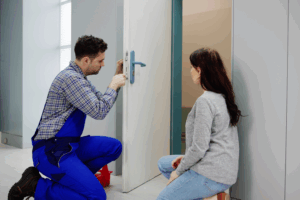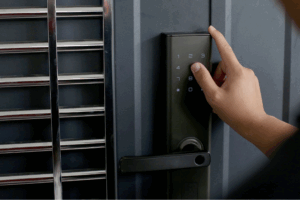As parents, one of our most important responsibilities is ensuring the safety and well-being of our children. When it comes to creating a safe environment at home, securing areas that are off-limits, dangerous, or not child-friendly is crucial. One of the best ways to do this is by childproofing your home locks. A good lock can be the difference between a child accessing a dangerous area and staying safe. In this guide, we’ll explore how to childproof your home locks to prevent accidents and enhance security.
1. Understand the Risks: Why Childproofing Locks Matters
Before diving into the practical aspects of childproofing, it’s essential to understand why locks are so important in safeguarding your child’s well-being.
Children’s natural curiosity can lead them into places they shouldn’t go. From cleaning supplies in the kitchen to medications in bathrooms, these hidden dangers can have catastrophic results if not properly secured. In fact, according to the American Academy of Pediatrics, unintentional injuries, such as falls, poisoning, and burns, are among the leading causes of child deaths in the United States. Installing childproof locks is a crucial first line of defense in mitigating these risks.
2. Choosing the Right Type of Locks for Childproofing Your Home
Childproofing your home locks goes beyond simply buying and installing locks. It’s essential to choose the right type of lock for different doors and cabinets to address specific needs in your home. Let’s take a look at some of the most effective lock options for childproofing.
Cabinet and Drawer Locks
Cabinet locks are a must in homes with toddlers or young children. Most cabinets in the kitchen or bathroom store cleaning chemicals, sharp objects, or medications that can be harmful if ingested or mishandled.
-
Magnetic Locks: These locks require a special key to unlock them, which parents can keep in a safe spot out of the child’s reach.
-
Adhesive Childproof Latches: Easy to install and ideal for temporary use, these latches are a budget-friendly option to keep cabinets closed.
-
Spring-Loaded Locks: These locks are placed on the inside of the cabinet doors, making them more difficult for children to access.
Doorknob Covers
Standard doorknobs can be difficult for children to grasp, but with the right covers, they become nearly impossible for children to open. The best options for childproofing doorknobs include:
-
Turn Knob Covers: These covers prevent children from turning the knob properly by making it harder to grip and rotate.
-
Doorknob Locks with Key: If you have rooms or areas that need to be securely locked, installing a doorknob lock with a key will allow you to control access effectively.
Sliding Glass Door Locks
Sliding glass doors, common in many homes, can be easy for children to open if not properly secured. You can install:
-
Slide Bolt Locks: A slide bolt lock can be added to the top or bottom track of the sliding door, making it impossible for little hands to open.
-
Securing Bars: A safety bar placed on the track can act as an extra layer of security, preventing the door from being slid open.
Window Locks
Windows can pose a significant risk, especially in multi-story homes. Children can fall out if they manage to open them, so it’s important to install window locks that restrict the window from opening fully. Look for:
-
Window Stops: These limit how far a window can open.
-
Double-Locking Window Locks: These locks require two actions to open, making them more challenging for children.
3. High or Out-of-Reach Locks for Extra Safety
While many locks are designed to be accessible to adults, some of the more secure models are harder for children to manipulate. Consider installing locks that are out of a child’s reach but still easy for you to operate. For example:
-
Top-Mount Locks: These locks are installed higher up on doors, windows, or cabinets and are generally out of reach for young children.
-
Keyed Locks: If your child is older and able to manipulate simpler locks, consider installing keyed locks that require a key to open. This ensures that access to restricted areas remains under your control.
4. Smart Locks for Extra Convenience and Control
For added security and convenience, consider installing smart locks in your home. Smart locks can be controlled remotely using your smartphone, allowing you to monitor access and control who enters and exits your home. Some models even allow you to set access permissions, so only certain individuals can unlock doors. These modern devices are not only childproof but also integrate well with smart home systems, adding an extra layer of security for your family.
Key Benefits of Smart Locks:
-
Remote Access: Lock and unlock doors from anywhere using your smartphone.
-
Custom Access: Grant temporary or permanent access to trusted individuals.
-
Automatic Locking: Set up your doors to lock automatically after a certain time, ensuring your home stays secure even if you forget.
5. Educating Your Child About Safety
Locks are an essential part of childproofing, but they work best when combined with education. It’s crucial to teach your child about the dangers of accessing certain areas. Even as they grow older and become more curious, reinforcing safety rules will help prevent them from attempting to bypass childproofing measures.
Here are some tips to teach your child:
-
Set Clear Boundaries: Explain why certain rooms (like the kitchen or garage) are off-limits and what dangers they may contain.
-
Model Safe Behavior: Demonstrate safe practices for your child and encourage them to follow your lead.
-
Praise and Reward: Encourage your child to follow safety rules by offering positive reinforcement when they adhere to them.
6. Maintaining Your Locks Regularly
Once you’ve installed your childproof locks, it’s important to check them periodically. As with any security measure, locks can wear down over time, and if they become damaged, they may no longer function properly. Keeping an eye on the locks and making necessary repairs will ensure they continue to provide effective protection.
Make sure to:
-
Inspect Locks Regularly: Check for loose screws or any signs of wear.
-
Test Functionality: Ensure that locks are still securing doors, cabinets, and windows properly.
-
Replace Damaged Locks: If a lock becomes damaged, replace it immediately to prevent access.
7. Childproofing Exterior Areas and Outdoor Spaces
While you may be focused on childproofing the inside of your home, don’t forget about outdoor areas such as gates, fences, garages, and sheds. Children can easily wander into these spaces, which can pose a variety of dangers, from sharp tools to the risk of falling.
-
Childproof Gate Locks: Install high-quality locks on gates that lead to yards or outdoor areas. Look for locks that are specifically designed to be difficult for young children to open.
-
Garage and Shed Locks: Tools, chemicals, and equipment in a garage can be highly dangerous to curious children. Make sure all exterior locks are secure and use additional deadbolts if needed.
8. Enlist a Locksmith for Professional Childproofing Solutions
While you can install many childproof locks yourself, it’s often a good idea to consult a professional locksmith. A locksmith can offer expert advice on the best types of locks for your home, install high-quality locks, and ensure that your childproofing efforts are as effective as possible. Whether you need assistance with upgrading existing locks, installing smart systems, or childproofing specific areas, a professional locksmith will help ensure your home is as safe as possible.
At Major Island Locksmith, we specialize in providing families with the most reliable and secure solutions for childproofing homes. Whether you need to install advanced locks or upgrade your security systems, we’re here to assist you with the best options. Feel free to reach out to us via email at info@majorislandlocksmith.com or call us at 516-779-6698 for personalized advice and services.




